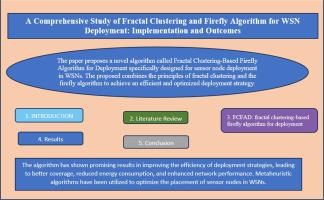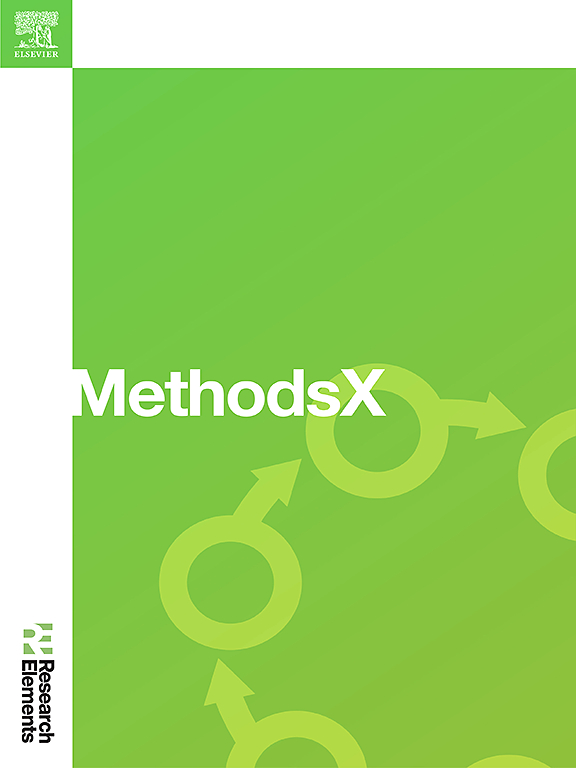针对 WSN 部署的分形聚类和萤火虫算法的综合研究:实施与成果
IF 1.6
Q2 MULTIDISCIPLINARY SCIENCES
引用次数: 0
摘要
无线传感器网络(WSN)已在各种应用领域得到广泛应用,并成为从偏远和难以接近的地区收集数据的可靠技术。无线传感器网络对于环境监测、监控和智能基础设施等现实世界的应用非常重要。网络覆盖、连通性和节能是 WSN 部署的重要因素。无线传感器网络(WSN)面临着能源消耗最小化、覆盖范围最大化和网络寿命改善等大量关键挑战。在现实世界的许多应用中,传感器节点都受到能源限制,并部署在资源有限的环境中。因此,低能耗对于延长网络寿命至关重要。同时,为了保证 WSN 的性能,必须确保以较低的能耗和全覆盖的方式进行数据传输。这些挑战是这项工作的核心重点,需要可扩展的高效部署策略。本文对 WSN 部署的优化技术进行了全面调查研究,以提高网络性能和资源利用率。本文还提出了一种名为 "基于分形聚类的萤火虫部署算法 "的新算法,该算法特别适用于 WSN 中传感器节点的部署。所提出的混合方法利用分形聚类和萤火虫优化算法的原理,制定了轻量级、高能效和增强型的优化部署策略。首先,该算法利用分形聚类技术将感兴趣的区域划分为具有相似属性的区域。这种聚类确定了传感器节点密度要求较高的区域--需要关键响应的事件或数据流量较高的区域。该算法通过虚拟萤火虫来表示每个聚类。萤火虫算法是一种受生物启发的蜂群智能优化技术,其灵感来源于萤火虫的闪光行为,萤火虫在输入参数空间中随机移动,以找到有利的部署配置。本文通过使用 MATLAB2020 对提出的算法进行仿真,并与其他部署策略进行比较,验证了该算法的效率。该分析表明结果很有希望。本文章由计算机程序翻译,如有差异,请以英文原文为准。

A comprehensive study of fractal clustering and firefly algorithm for WSN Deployment: Implementation and outcomes
Wireless sensor networks (WSNs) have been highly utilized and defensible technology in diverse application areas for data gathering from remote and hard-to-approach regions. Wireless Sensor Networks are substantially important for the real-world applications such as environmental monitoring, surveillance, and smart infrastructure. Network coverage, connectivity and energy savings are significant factors in the WSN deployment. Wireless sensor networks (WSNs) undergo a great deal of crucial challenges such as minimize energy consumption, maximize coverage, and network lifetime improvement. Sensor nodes are energy constrained and deployed in resource-constrained environments for many real-world applications. Low energy usage is hence crucial to prolong network life. Meanwhile, to guarantee the performance of a WSN, it is crucial to ensure data transmission with less energy consumption and full coverage. These challenges are the central focus of this work, requiring scalable and efficient deployment strategies. In this paper, a complete survey study on optimization technique for deployment of WSN to improve network performance and resource utilization is offered. The paper also suggests a new algorithm named as Fractal Clustering Based Firefly Deployment Algorithm which is particularly designed for the deployment of sensor nodes deployed in WSNs. The proposed hybridize method uses the principles of fractal clustering and firefly optimization algorithm to make light-weight, energy efficient and enhanced optimized deployment strategy. To start with, the algorithm makes use of a fractal clustering technique to partition an area of interest into regions that have similar attributes. This clustering determines the areas that are needed to have higher sensor node density requirements — regions where events requiring a critical response or data traffic are high. The algorithm represents each cluster by a virtual firefly. The firefly algorithm is a biologically-inspired swarm intelligence optimization technique, inspired by the flashing behavior of fireflies which stochastically moves through input parameter space to find favorable deployment configurations. In this paper, the efficiency of the algorithm is verified by simulating the proposed algorithm using MATLAB2020 and comparing it with other deployment strategies. This analysis shows promising results.
求助全文
通过发布文献求助,成功后即可免费获取论文全文。
去求助
来源期刊

MethodsX
Health Professions-Medical Laboratory Technology
CiteScore
3.60
自引率
5.30%
发文量
314
审稿时长
7 weeks
期刊介绍:
 求助内容:
求助内容: 应助结果提醒方式:
应助结果提醒方式:


